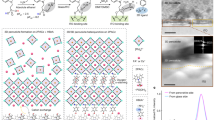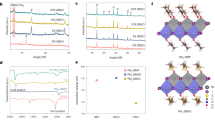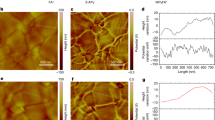Abstract
Inverted perovskite solar cells have attracted increasing attention because they have achieved long operating lifetimes. However, they have exhibited significantly inferior power conversion efficiencies compared to regular perovskite solar cells. Here we reduce this efficiency gap using a trace amount of surface-anchoring alkylamine ligands (AALs) with different chain lengths as grain and interface modifiers. We show that long-chain AALs added to the precursor solution suppress nonradiative carrier recombination and improve the optoelectronic properties of mixed-cation mixed-halide perovskite films. The resulting AAL surface-modified films exhibit a prominent (100) orientation and lower trap-state density as well as enhanced carrier mobilities and diffusion lengths. These translate into a certified stabilized power conversion efficiency of 22.3% (23.0% power conversion efficiency for lab-measured champion devices). The devices operate for over 1,000 h at the maximum power point under simulated AM1.5 illumination, without loss of efficiency.
This is a preview of subscription content, access via your institution
Access options
Access Nature and 54 other Nature Portfolio journals
Get Nature+, our best-value online-access subscription
$29.99 / 30 days
cancel any time
Subscribe to this journal
Receive 12 digital issues and online access to articles
$119.00 per year
only $9.92 per issue
Buy this article
- Purchase on Springer Link
- Instant access to full article PDF
Prices may be subject to local taxes which are calculated during checkout






Similar content being viewed by others
Data availability
The main data supporting the findings of this study are available within the article and its Supplementary Information. Additional data are available from the corresponding authors on reasonable request.
References
Kojima, A., Teshima, K., Shirai, Y. & Miyasaka, T. Organometal halide perovskites as visible-light sensitizers for photovoltaic cells. J. Am. Chem. Soc. 131, 6050–6051 (2009).
Yang, M. et al. Perovskite ink with wide processing window for scalable high-efficiency solar cells. Nat. Energy 2, 17038 (2017).
Zhao, D. et al. Efficient two-terminal all-perovskite tandem solar cells enabled by high-quality low-bandgap absorber layers. Nat. Energy 3, 1093–1100 (2018).
Wehrenfennig, C., Eperon, G. E., Johnston, M. B., Snaith, H. J. & Herz, L. M. High charge carrier mobilities and lifetimes in organolead trihalide perovskites. Adv. Mater. 26, 1584–1589 (2014).
Shi, D. et al. Low trap-state density and long carrier diffusion in organolead trihalide perovskite single crystals. Science 347, 519–522 (2015).
Dong, Q. et al. Electron-hole diffusion lengths > 175 μm in solution-grown CH3NH3PbI3 single crystals. Science 347, 967–970 (2015).
Chen, Z. et al. Single-crystal MAPbI3 perovskite solar cells exceeding 21% power conversion efficiency. ACS Energy Lett. 4, 1258–1259 (2019).
National Renewable Energy Laboratory. Best research-cell efficiencies. www.nrel.gov/pv/assets/pdfs/pv-efficiency-chart.20190103.pdf (2019).
Christians, J. A. et al. Tailored interfaces of unencapsulated perovskite solar cells for >1,000 hour operational stability. Nat. Energy 3, 68–74 (2018).
Bai, S. et al. Planar perovskite solar cells with long-term stability using ionic liquid additives. Nature 571, 245–250 (2019).
Yang, S. et al. Stabilizing halide perovskite surfaces for solar cell operation with wide-bandgap lead oxysalts. Science 365, 473–478 (2019).
Jiang, Q. et al. Surface passivation of perovskite film for efficient solar cells. Nat. Photonics 13, 460–466 (2019).
Luo, D. et al. Enhanced photovoltage for inverted planar heterojunction perovskite solar cells. Science 360, 1442–1446 (2018).
Turren-Cruz, S.-H., Hagfeldt, A. & Saliba, M. Methylammonium-free, high-performance, and stable perovskite solar cells on a planar architecture. Science 362, 449–453 (2018).
Zheng, X. et al. Defect passivation in hybrid perovskite solar cells using quaternary ammonium halide anions and cations. Nat. Energy 2, 17102 (2017).
Bi, D. et al. Polymer-templated nucleation and crystal growth of perovskite films for solar cells with efficiency greater than 21%. Nat. Energy 1, 16142 (2016).
Zheng, X. et al. Quantum dots supply bulk- and surface-passivation agents for efficient and stable perovskite solar cells. Joule 3, 1963–1976 (2019).
Tong, J. et al. Carrier lifetimes of >1 μs in Sn-Pb perovskites enable efficient all-perovskite tandem solar cells. Science 364, 475–479 (2019).
Wang, Z. et al. Efficient ambient-air-stable solar cells with 2D–3D heterostructured butylammonium-caesium-formamidinium lead halide perovskites. Nat. Energy 2, 17135 (2017).
Deng, Y. et al. Surfactant-controlled ink drying enables high-speed deposition of perovskite films for efficient photovoltaic modules. Nat. Energy 3, 560–566 (2018).
Li, N. et al. Cation and anion immobilization through chemical bonding enhancement with fluorides for stable halide perovskite solar cells. Nat. Energy 4, 408 (2019).
Wang, Y. et al. Stabilizing heterostructures of soft perovskite semiconductors. Science 365, 687–691 (2019).
Chen, M. et al. Highly stable and efficient all-inorganic lead-free perovskite solar cells with native-oxide passivation. Nat. Commun. 10, 16 (2019).
Jao, M.-H., Lu, C.-F., Tai, P.-Y. & Su, W.-F. Precise facet engineering of perovskite single crystals by ligand-mediated strategy. Cryst. Growth Des. 17, 5945–5952 (2017).
Muscarella, L. A. et al. Air-stable and oriented mixed lead halide perovskite (FA/MA) by the one-step deposition method using zinc iodide and an alkylammonium additive. ACS Appl. Mater. Interfaces 11, 17555–17562 (2019).
Wu, W.-Q. et al. Bilateral alkylamine for suppressing charge recombination and improving stability in blade-coated perovskite solar cells. Sci. Adv. 5, eaav8925 (2019).
Yang, S. et al. Tailoring passivation molecular structures for extremely small open-circuit voltage loss in perovskite solar cells. J. Am. Chem. Soc. 141, 5781–5787 (2019).
Proppe, A. H. et al. Photochemically cross-linked quantum well ligands for 2D/3D perovskite photovoltaics with improved photovoltage and stability. J. Am. Chem. Soc. 141, 14180–14189 (2019).
Qing, J. et al. High-quality Ruddlesden–Popper perovskite films based on in situ formed organic spacer cations. Adv. Mater. 31, 1904243 (2019).
Fei, C. et al. Self-assembled propylammonium cations at grain boundaries and the film surface to improve the efficiency and stability of perovskite solar cells. J. Mater. Chem. A 7, 23739–23746 (2019).
Wang, Q., Dong, Q., Li, T., Gruverman, A. & Huang, J. Thin insulating tunneling contacts for efficient and water-resistant perovskite solar cells. Adv. Mater. 28, 6734–6739 (2016).
Lin, Y. et al. Suppressed ion migration in low-dimensional perovskites. ACS Energy Lett. 2, 1571–1572 (2017).
Xiao, X. et al. Suppressed ion migration along the in-plane direction in layered perovskites. ACS Energy Lett. 3, 684–688 (2018).
Yoo, J. J. et al. An interface stabilized perovskite solar cell with high stabilized efficiency and low voltage loss. Energy Environ. Sci. 12, 2192–2199 (2019).
Zuo, L. et al. Polymer-modified halide perovskite films for efficient and stable planar heterojunction solar cells. Sci. Adv. 3, e1700106 (2017).
Koh, T. M. et al. Enhancing moisture tolerance in efficient hybrid 3D/2D perovskite photovoltaics. J. Mater. Chem. A 6, 2122–2128 (2018).
Yang, S. et al. Functionalization of perovskite thin films with moisture-tolerant molecules. Nat. Energy 1, 15016 (2016).
Quintero-Bermudez, R. et al. Ligand-induced surface charge density modulation generates local type-II band alignment in reduced-dimensional perovskites. J. Am. Chem. Soc. 141, 13459–13467 (2019).
Zhou, T. et al. Highly efficient and stable solar cells based on crystalline oriented 2D/3D hybrid perovskite. Adv. Mater. 31, 1901242 (2019).
Liu, Y. et al. Ultrahydrophobic 3D/2D fluoroarene bilayer-based water-resistant perovskite solar cells with efficiencies exceeding 22%. Sci. Adv. 5, eaaw2543 (2019).
Jodlowski, A. D. et al. Large guanidinium cation mixed with methylammonium in lead iodide perovskites for 19% efficient solar cells. Nat. Energy 2, 972–979 (2017).
Jeon, N. J. et al. Solvent engineering for high-performance inorganic–organic hybrid perovskite solar cells. Nat. Mater. 13, 897 (2014).
Yang, R. et al. Oriented quasi-2D perovskites for high performance optoelectronic devices. Adv. Mater. 30, 1804771 (2018).
Gong, X. et al. Contactless measurements of photocarrier transport properties in perovskite single crystals. Nat. Commun. 10, 1591 (2019).
Lee, E. M. Y. & Tisdale, W. A. Determination of exciton diffusion length by transient photoluminescence quenching and its application to quantum dot films. J. Phys. Chem. C 119, 9005–9015 (2015).
Jariwala, S. et al. Local crystal misorientation influences non-radiative recombination in halide perovskites. Joule 3, 3048–3060 (2019).
Zhang, L. et al. Exploring anisotropy on oriented wafers of MAPbBr3 crystals grown by controlled antisolvent diffusion. Cryst. Growth Des. 18, 6652–6660 (2018).
Kim, D. et al. Probing facet-dependent surface defects in MAPbI3 perovskite single crystals. J. Phys. Chem. C 123, 14144–14151 (2019).
Kresse, G. & Hafner, J. Ab initio molecular dynamics for open-shell transition metals. Phys. Rev. B 48, 13115–13118 (1993).
Kresse, G. & Furthmüller, J. Efficient iterative schemes for ab initio total-energy calculations using a plane-wave basis set. Phys. Rev. B 54, 11169–11186 (1996).
Quarti, C., De Angelis, F. & Beljonne, D. Influence of surface termination on the energy level alignment at the CH3NH3PbI3 perovskite/C60 interface. Chem. Mater. 29, 958–968 (2017).
Stranks, S. D. et al. Recombination kinetics in organic–inorganic perovskites: excitons, free charge, and subgap states. Phys. Rev. Applied 2, 034007 (2014).
Habisreutinger, S. N., Noel, N. K., Snaith, H. J. & Nicholas, R. J. Investigating the role of 4-tert butylpyridine in perovskite solar cells. Adv. Energy Mater. 7, 1601079 (2017).
Li, D. et al. Electronic and ionic transport dynamics in organolead halide perovskites. ACS Nano 10, 6933–6941 (2016).
Pan, W. et al. Cs2AgBiBr6 single-crystal X-ray detectors with a low detection limit. Nat. Photonics 11, 726–732 (2017).
Acknowledgements
We acknowledge the use of KAUST Core Lab and KAUST Solar Center facilities. This work was supported by KAUST and the Office of Sponsored Research (OSR) under award no. OSR-2017-CRG-3380. F.G. is a Wallenberg Academy Fellow.
Author information
Authors and Affiliations
Contributions
O.M.B., X.Z., Y.H. and E.H.S. conceived the idea and designed the experiments. X.Z. fabricated the devices and conducted the characterizations. Y.H. contributed to device fabrication and evaluation, the MPP stability test and TRPL measurement. C.B. contributed to the measurements of thermal admittance spectroscopy, transient photo-voltage, ion migration and LEDs. J.Y. performed and interpreted the DFT calculation. J.L. performed the XRD measurements. A.K.J. performed the GIWAXS measurements. K.S., J.L., N.W., B.T. and C.Y. contributed to the electron microscopy measurements. N.G. contributed to the light-intensity-dependent J–V measurements. Y.L. contributed to the atomic force microscopy and contact angle measurements. A.Y.A. contributed to the PL measurements and PL mapping. F.Y., C.Z., Z.H., P.M., D.X., B.C. and M.W. contributed to TRPL and analyses. M.N.H. performed the UPS measurements. J.T. contributed to the stability measurements. D.B., T.D.A., Y.H., Z.H.L., O.F.M., F.G. and E.H.S. provided advice and expertise. X.Z., O.M.B., Y.H. and E.H.S. composed the manuscript. All authors discussed the results and commented on the manuscript.
Corresponding authors
Ethics declarations
Competing interests
The authors declare no competing interests.
Additional information
Publisher’s note Springer Nature remains neutral with regard to jurisdictional claims in published maps and institutional affiliations.
Supplementary information
Supplementary Information
Supplementary Figs. 1–20
Rights and permissions
About this article
Cite this article
Zheng, X., Hou, Y., Bao, C. et al. Managing grains and interfaces via ligand anchoring enables 22.3%-efficiency inverted perovskite solar cells. Nat Energy 5, 131–140 (2020). https://doi.org/10.1038/s41560-019-0538-4
Received:
Accepted:
Published:
Issue Date:
DOI: https://doi.org/10.1038/s41560-019-0538-4
This article is cited by
-
Alkyl ammonium iodide-based ligand exchange strategy for high-efficiency organic-cation perovskite quantum dot solar cells
Nature Energy (2024)
-
Triple-junction solar cells with cyanate in ultrawide-bandgap perovskites
Nature (2024)
-
Harnessing strong aromatic conjugation in low-dimensional perovskite heterojunctions for high-performance photovoltaic devices
Nature Communications (2024)
-
Enhancing the efficiency and longevity of inverted perovskite solar cells with antimony-doped tin oxides
Nature Energy (2024)
-
Machine learning guided rapid discovery of narrow-bandgap inorganic halide perovskite materials
Applied Physics A (2024)



